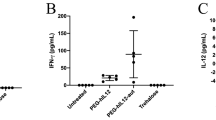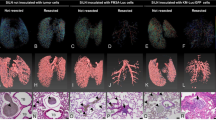Abstract
Tumors require ongoing angiogenesis to support their growth. Inhibition of angiogenesis by production of antiangiogenic factors should be a viable approach for cancer gene therapy. In this study, we investigated whether intravenous administration of endostatin gene complexed with a cationic vector (GL67/DOPE or PEI22K) could inhibit the development of lung tumors in mice injected i.v. with NFSa Y83 fibrosarcoma cells (5×105) which frequently form lung metastasis. mRNA and protein of the transfected gene were produced in the lung and other organs of the transfected mice as assessed by immunohistochemistry, Western blotting and reverse transcription-polymerase chain reaction. Single intravenous injection of the endostatin gene (60 μg) complexed with either GL67/DOPE or PEI22K on day 3 or day 7 after fibrosarcoma cell inoculation significantly inhibited tumor formation in the lung as evidenced by the reduced number of lung tumors and lung weight, and prolonged survival of the endostatin gene-transfected mice compared with control mice. These findings suggested that the endostatin gene therapy, using cationic vector-mediated intravenous gene transfer, might be a feasible strategy for organ-targeted prevention and regulation of possible disseminated cancers.
This is a preview of subscription content, access via your institution
Access options
Subscribe to this journal
Receive 12 print issues and online access
$259.00 per year
only $21.58 per issue
Buy this article
- Purchase on Springer Link
- Instant access to full article PDF
Prices may be subject to local taxes which are calculated during checkout







Similar content being viewed by others
References
OReilly MS, Boehm T, Shing Y . Endostatin: an endogenous inhibitor of angiogenesis and tumor growth. Cell 1997; 88: 277–285.
Nguyen JT, Wu P, Clouse ME . Adeno-associated virus-mediated delivery of antiangiogenic factors as an antitumor strategy. Cancer Res 1998; 58: 5673–5677.
Dhanabal M, Ramchandran R, Volk R . Endostatin: yeast production, mutants, and antitumor effect in renal cell carcinoma. Cancer Res 1999; 59: 189–197.
Blezinger P, Wang J, Gondo M . Systemic inhibition of tumor growth and tumor metastases by intramuscular administration of the endostatin gene. Nat Biotechnol 1999; 17: 343–348.
Folkman J . Angiogenesis in cancer, vascular, rheumatoid and other disease. Nat Med 1995; 1: 27–31.
Hanahan D, Folkman J . Patterns and emerging mechanisms of the angiogenic switch during tumorigenesis. Cell 1996; 86: 353–364.
Boehm T, Folkman J, Browder T . Antiangiogenic therapy of experimental cancer does not induce acquired drug resistance. Nature 1997; 390: 404–407.
Putney SD, Burke PA . Improving protein therapeutics with sustained-release formulations. Nat Biotechnol 1998; 16: 153–157.
Crystal RG . The body as a manufacturer of endostatin. Nat Biotechnol 1999; 17: 336–337.
Huang X, Wong MKK, Zhao Q . Soluble recombinant endostatin purified from Escherichia coli: antiangiogenic activity and antitumor effect. Cancer Res 2001; 61: 478–481.
Kisker O, Becker CM, Prox D . Continuous administration of endostatin by intraperitoneally implanted osmotic pump improves the efficacy and potency of therapy in a mouse xenograft tumor model. Cancer Res 2001; 61: 7669–7674.
Folkman J . Antiangiogenic gene therapy. Proc Natl Acad Sci USA 1998; 95: 9064–9066.
Kong HL, Crystal RG . Gene therapy strategies for tumor antiangiogenesis. J Natl Cancer Inst 1998; 90: 273–286.
Tanaka T, Cao YH, Folkman J . Viral vector-targeted antiangiogenic gene therapy utilizing an angiostatin complementary DNA. Cancer Res 1998; 58: 3362–3369.
Goldman CK, Kendall RL, Cabrera G . Paracrine expression of a native soluble vascular endothelial growth factor receptor inhibits tumor growth, metastasis, and mortality rate. Proc Natl Acad Sci USA 1998; 95: 8795–8800.
Lin P, Buxton JA, Acheson A . Antiangiogenic gene therapy targeting the endothelium-specific receptor tyrosine kinase Tie2. Proc Natl Acad Sci USA 1998; 95: 8829–8834.
Griscelli F, Li H, Bennaceur-Griscelli A . Angiostatin gene transfer: inhibition of tumor growth in vivo by blockage of endothelial cell proliferation associated with a mitosis arrest. Proc Natl Acad Sci USA 1998; 95: 6367–6372.
Kong HL, Hecht D, Song W . Regional suppression of tumor growth by in vivo transfer of a cDNA encoding a secreted form of the extracellular domain of the flt-1 vascular endothelial growth factor receptor. Hum Gene Ther 1998; 9: 823–833.
Zabner J, Ramsey BW, Meeker DP . Repeat administration of an adenovirus vector encoding cystic fibrosis transmembrane conductance regulator to the nasal epithelium of patients with cystic fibrosis. J Clin Investig 1996; 97: 1504–1511.
Fisher KJ, Choi H, Burda J . Recombinant adenovirus deleted of all viral genes for gene therapy of cystic fibrosis. Virology 1996; 217: 11–22.
Yei S, Mittereder N, Tang K . Adenovirus-mediated gene transfer for cystic fibrosis: quantitative evaluation of repeated in vivo vector administration to the lung. Gene Ther 1994; 1: 192–200.
Yang Y, Li Q, Ertl HC . Cellular and humoral immune responses to viral antigens create barriers to lung-directed gene therapy with recombinant adenoviruses. J Virol 1995; 69: 2004–2015.
Cassivi SD, Liu M, Boehler A . Transgene expression after adenovirus-mediated retransfection of rat lungs is increased and prolonged by transplant immunosuppression. J Thorac Cardiovasc Surg 1999; 117: 1–7.
Lesoon-Wood LA, Kim WH, Kleinman HK . Systemic gene therapy with p53 reduces growth and metastases of a malignant human breast cancer in nude mice. Hum Gene Ther 1995; 6: 395–405.
Nabel EG, Gordon D, Yang ZY . Gene transfer in vivo with DNA–liposome complexes: lack of autoimmunity and gonadal localization. Hum Gene Ther 1992; 3: 649–656.
Stewart MJ, Plautz GE, Del Buono L . Gene transfer in vivo with DNA–liposome complexes: safety and acute toxicity in mice. Hum Gene Ther 1992; 3: 267–275.
Xu M, Kumar D, Srinivas S . Parenteral gene therapy with p53 inhibits human breast tumors in vivo through a bystander mechanism without evidence of toxicity. Hum Gene Ther 1997; 8: 177–185.
Chen QR, Kumar D, Stass SA . Liposomes complexed to plasmids encoding angiostatin and endostatin inhibit breast cancer in nude mice. Cancer Res 1999; 59: 3308–3312.
Zhu N, Liggitt D, Liu Y . Systemic gene expression after intravenous DNA delivery into adult mice. Science 1993; 261: 209–211.
Liu Y, Liggitt D, Zhong W . Cationic liposome-mediated intravenous gene delivery. J Biol Chem 1995; 270: 24 864–24 870.
Thierry AR, Lunardi-Iskandar Y, Bryant JL . Systemic gene therapy: biodistribution and long-term expression of a transgene in mice. Proc Natl Acad Sci USA 1995; 92: 9742–9746.
Li S, Huang L . In vivo gene transfer via intravenous administration of cationic lipid–protamine–DNA (LPD) complexes. Gene Ther 1997; 4: 891–900.
Thierry AR, Rabinovich P, Peng B . Characterization of liposome-mediated gene delivery: expression, stability and pharmacokinetics of plasmid DNA. Gene Ther 1997; 4: 226–237.
Liu Y, Mounkes LC, Liggitt HD . Factors influencing the efficiency of cationic liposome-mediated intravenous gene delivery. Nat Biotechnol 1997; 15: 167–173.
Griesenbach U, Chonn A, Cassady R . Comparison between intratracheal and intravenous administration of liposome–DNA complexes for cystic fibrosis lung gene therapy. Gene Ther 1998; 5: 181–188.
Bragonzi A, Boletta A, Biffi A . Comparison between cationic polymers and lipids in mediating systemic gene delivery to the lungs. Gene Ther 1999; 6: 1995–2004.
Goula D, Benoist C, Mantero S . Polyethylenimine-based intravenous delivery of transgenes to mouse lung. Gene Ther 1998; 5: 1291–1295.
Bennett MJ, Nantz MH, Balasubramaniam RP . Cholesterol enhances cationic liposome-mediated DNA transfection of human respiratory epithelial cells. Biosci Rep 1995; 15: 47–53.
Felgner PL, Ringold GM . Cationic liposome-mediated transfection. Nature 1989; 337: 387–388.
Ferry N, Heard JM . Liver-directed gene transfer vectors. Hum Gene Ther 1998; 9: 1975–1981.
Tomko RP, Xu R, Philipson L . HCAR and MCAR: the human and mouse cellular receptors for subgroup C adenoviruses and group B coxsackieviruses. Proc Natl Acad Sci USA 1997; 94: 3352–3356.
Michou AI, Santoro L, Christ M . Adenovirus-mediated gene transfer: influence of transgene, mouse strain and type of immune response on persistence of transgene expression. Gene Ther 1997; 4: 473–482.
Bergers G, Javaherian K, Lo KM . Effects of angiogenesis inhibitors on multistage carcinogenesis in mice. Science 1999; 284: 808–812.
Nagahiro I et al. Toxicity of cationic liposome–DNA complex in lung isografts. Transplantation 2000; 69: 1802–1805.
Acknowledgements
We are grateful to Dr RK Scheule, Ms L Leontie and Ms K Girard (Genzyme Corporation) for providing GL67/DOPE. We thank Ms A Miyazaki, Ms M Nishio and Ms S Makino for technical assistance, and Dr Koichi Ando for providing murine fibrosarcoma cell line NFSa Y83.
Author information
Authors and Affiliations
Additional information
This work was supported in part by a Grant-in-Aid for Scientific Research on Priority Areas from the Ministry of Education, Science and Culture of Japan
Rights and permissions
About this article
Cite this article
Nakashima, Y., Yano, M., Kobayashi, Y. et al. Endostatin gene therapy on murine lung metastases model utilizing cationic vector-mediated intravenous gene delivery. Gene Ther 10, 123–130 (2003). https://doi.org/10.1038/sj.gt.3301856
Received:
Accepted:
Published:
Issue Date:
DOI: https://doi.org/10.1038/sj.gt.3301856
Keywords
This article is cited by
-
Inhibiting adenoid cystic carcinoma cells growth and metastasis by blocking the expression of ADAM 10 using RNA interference
Journal of Translational Medicine (2010)
-
RNAi-mediated ADAM9 gene silencing inhibits metastasis of adenoid cystic carcinoma cells
Tumor Biology (2010)
-
Cationic liposome coupled endostatin gene for treatment of peritoneal colon cancer
Clinical & Experimental Metastasis (2010)
-
Liposome–DNA complexes infused intravenously inhibit tumor angiogenesis and elicit antitumor activity in dogs with soft tissue sarcoma
Cancer Gene Therapy (2006)
-
Endostatin gene transfection using a cationic lipid: advantages of transfection before tumor cell inoculation and repeated transfection
Cancer Gene Therapy (2004)



